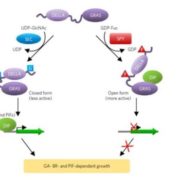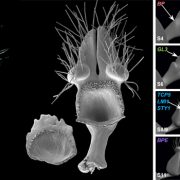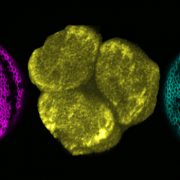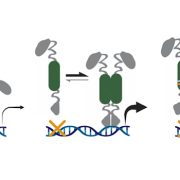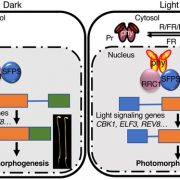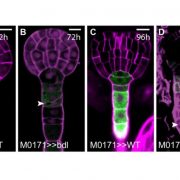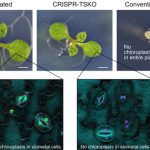Plant Science Research Weekly: October 18
Guest Editor :
Suresh Damodaran
 I am a postdoctoral research associate in Dr. Lucia Strader’s lab at WUSTL. My primary area of interest is understanding the role of plant hormones in development. I completed my graduate degree in Dr. Sen Subramanian’s lab at SDSTATE. Twitter: @SureshDamod
I am a postdoctoral research associate in Dr. Lucia Strader’s lab at WUSTL. My primary area of interest is understanding the role of plant hormones in development. I completed my graduate degree in Dr. Sen Subramanian’s lab at SDSTATE. Twitter: @SureshDamod
Design principles of a minimal auxin response system ($)
 Auxin signaling components are evolutionarily conserved across the land plants and the duplication events in these regulators enabled complexity in development. Auxin regulated developmental programming occurs through the ARF (AUXIN RESPONSE FACTORS) transcriptional factors. Marchantia polymorpha serves as an ideal system to understand ARF activity owing to its simpler genome complexity. In their previous work, Weijer’s Lab has shown the importance of the three ARF protein in M. polymorpha development. In this paper, Kato et al., have identified the mechanism by which A-ARF and B-ARF define developmental programming by regulating the expression of downstream auxin-responsive genes. Until recently the precise mechanism by which the class B- ARFs can repress gene expression is unknown. Using M. polymorpha, the authors have shown that B-ARF can act antagonistically by binding to A-ARF target sites. This resolves one more piece in the large puzzle of auxin signaling and activation of gene expression for plant development. Summary by Suresh Damodaran. BioRxiv, https://doi.org/10.1101/760876
Auxin signaling components are evolutionarily conserved across the land plants and the duplication events in these regulators enabled complexity in development. Auxin regulated developmental programming occurs through the ARF (AUXIN RESPONSE FACTORS) transcriptional factors. Marchantia polymorpha serves as an ideal system to understand ARF activity owing to its simpler genome complexity. In their previous work, Weijer’s Lab has shown the importance of the three ARF protein in M. polymorpha development. In this paper, Kato et al., have identified the mechanism by which A-ARF and B-ARF define developmental programming by regulating the expression of downstream auxin-responsive genes. Until recently the precise mechanism by which the class B- ARFs can repress gene expression is unknown. Using M. polymorpha, the authors have shown that B-ARF can act antagonistically by binding to A-ARF target sites. This resolves one more piece in the large puzzle of auxin signaling and activation of gene expression for plant development. Summary by Suresh Damodaran. BioRxiv, https://doi.org/10.1101/760876
Minimal auxin sensing levels in vegetative moss stem cells revealed by a ratiometric reporter ($)
 Auxin plays multiple developmental roles from embryogenesis to seed development. To understand the mechanism of auxin response in plants, researchers utilize the early-diverging land plant models, Physcomitrella patens and Marchantia polymorpha. In this paper, Thelander et al., have identified a specific reporter of auxin levels for P.patens, PpR2D2 (Ratiometric version of DII-nVENUS to mDII-nTdTOMATO signal). This reporter developed for P. patens similar to Arabidopsis serves as a proxy for detecting TIR/AFB (TRANSPORT INHIBITOR RESISTANT1/AUXIN F-BOX) dependent auxin sensing system. PpR2D2 can detect very minimal levels of auxin during the early development of the moss, P.patens which enable researchers to understand the core auxin mechanism in development. The authors have validated the expression of this marker to the other auxin output marker DR5 and have demonstrated the significance of this marker in different growth stages of P.patens and also in response to exogenous auxin. Thus an added tool to dissecting auxin role in plant development has been shown. Summary by Suresh Damodaran, New Phytologist, https://doi.org/10.1111/nph.16068
Auxin plays multiple developmental roles from embryogenesis to seed development. To understand the mechanism of auxin response in plants, researchers utilize the early-diverging land plant models, Physcomitrella patens and Marchantia polymorpha. In this paper, Thelander et al., have identified a specific reporter of auxin levels for P.patens, PpR2D2 (Ratiometric version of DII-nVENUS to mDII-nTdTOMATO signal). This reporter developed for P. patens similar to Arabidopsis serves as a proxy for detecting TIR/AFB (TRANSPORT INHIBITOR RESISTANT1/AUXIN F-BOX) dependent auxin sensing system. PpR2D2 can detect very minimal levels of auxin during the early development of the moss, P.patens which enable researchers to understand the core auxin mechanism in development. The authors have validated the expression of this marker to the other auxin output marker DR5 and have demonstrated the significance of this marker in different growth stages of P.patens and also in response to exogenous auxin. Thus an added tool to dissecting auxin role in plant development has been shown. Summary by Suresh Damodaran, New Phytologist, https://doi.org/10.1111/nph.16068
A Simple and sensitive SYBR Gold-based assay to quantify DNA-Protein interactions ($)
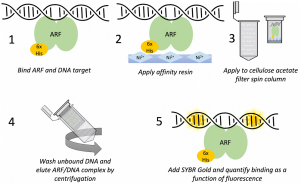 Gene regulation occurs at multiple levels including transcription. During transcription, transcriptional factors bind to specific target sequence which allows the recruitment of other proteins including RNA polymerase that enables transcription. Understanding such an intricate mechanism allows researchers to study the spatio-temporal expression pattern of genes necessary for development or inducing signals during biotic or abiotic stress. In this paper Schreier et al., have developed an in-vitro assay that allows quantification of DNA-protein interaction. The authors have evaluated this simple assay using known binding sites of the transcriptional factor, AUXIN RESPONSE FACTOR (ARF) from Arabidopsis and soybean and shown differential binding strength. The phytohormone auxin regulates its downstream gene expression through specific ARF activity and understanding this mechanism of preferential binding for development or stress response. Overall, a new assay has been developed for the in-vitro analysis of the strength of protein DNA interaction. Summary by Suresh Damodaran. Plant Molecular Biology,https://doi.org/10.1007/s11103-019-00922-x
Gene regulation occurs at multiple levels including transcription. During transcription, transcriptional factors bind to specific target sequence which allows the recruitment of other proteins including RNA polymerase that enables transcription. Understanding such an intricate mechanism allows researchers to study the spatio-temporal expression pattern of genes necessary for development or inducing signals during biotic or abiotic stress. In this paper Schreier et al., have developed an in-vitro assay that allows quantification of DNA-protein interaction. The authors have evaluated this simple assay using known binding sites of the transcriptional factor, AUXIN RESPONSE FACTOR (ARF) from Arabidopsis and soybean and shown differential binding strength. The phytohormone auxin regulates its downstream gene expression through specific ARF activity and understanding this mechanism of preferential binding for development or stress response. Overall, a new assay has been developed for the in-vitro analysis of the strength of protein DNA interaction. Summary by Suresh Damodaran. Plant Molecular Biology,https://doi.org/10.1007/s11103-019-00922-x
Fine control of aerenchyma and lateral root development through Aux/IAA- and ARF-dependent auxin signaling ($)
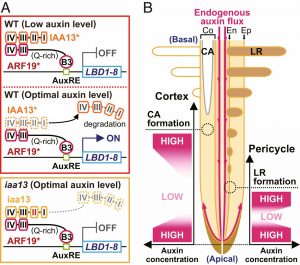 Auxin plays a major role in plant development and can alter the developmental program following the stress response. In this paper, Yamauchi et al., have identified the auxin signaling cascade involved in the development of aerenchyma and regulators of this auxin signaling might also be involved in lateral root development. Aerenchyma is a gas-filled space in plant root tissue arising through programmed cell death which is formed constitutively in rice roots. The formation of aerenchyma is induced further under waterlogged/ oxygen-deficient condition and this process is dependent on auxin signaling. The auxin co-receptor Aux/IAA protein, IAA13 is shown to interact with the AUXIN RESPONSE FACTOR, ARF19. Increased auxin levels in cells cause degradation of IAA13 to release ARF19 repression and activation of LBD1-8 (lateral organ boundary domain (LBD) containing protein). Proper auxin levels and the subsequent LBD1-8 activation by ARF19 is crucial for aerenchyma formation as well as lateral root development in rice roots under optimal growth condition. Summary by Suresh Damodaran. PNAS, https://doi.org/10.1073/pnas.1907181116
Auxin plays a major role in plant development and can alter the developmental program following the stress response. In this paper, Yamauchi et al., have identified the auxin signaling cascade involved in the development of aerenchyma and regulators of this auxin signaling might also be involved in lateral root development. Aerenchyma is a gas-filled space in plant root tissue arising through programmed cell death which is formed constitutively in rice roots. The formation of aerenchyma is induced further under waterlogged/ oxygen-deficient condition and this process is dependent on auxin signaling. The auxin co-receptor Aux/IAA protein, IAA13 is shown to interact with the AUXIN RESPONSE FACTOR, ARF19. Increased auxin levels in cells cause degradation of IAA13 to release ARF19 repression and activation of LBD1-8 (lateral organ boundary domain (LBD) containing protein). Proper auxin levels and the subsequent LBD1-8 activation by ARF19 is crucial for aerenchyma formation as well as lateral root development in rice roots under optimal growth condition. Summary by Suresh Damodaran. PNAS, https://doi.org/10.1073/pnas.1907181116
Auxin-sensitive AUX/IAA proteins mediate drought tolerance in Arabidopsis by regulating glucosinolates levels ($)
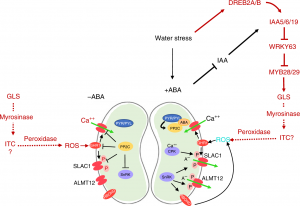 Glucosinolates are secondary metabolites synthesized by plants as a defense compound against pathogen and herbivore. In this paper Salehin et al., have demonstrated regulation of aliphatic glucosinolate levels by auxin signaling that promotes drought tolerance in Arabidopsis. The Aux/IAA proteins are coreceptors of auxin and repress the activity of AUXIN RESPONSE FACTOR (ARF) bound to it. Of the 29 Aux/IAA genes, there are redundant and specific functions to each member adding complexity to auxin signaling in plant development and stress response. Under a water deficit condition, the levels of aliphatic glucosinolates were down-regulated in the iaa5,6,19 mutants suggesting a potential role of IAA5,6 and 19 are essential for drought tolerance. Further, it has been shown that these AUX/IAA proteins are necessary for stomatal regulation and altered glucosinolate levels in the iaa5,6,19 mutants lead to defective stomatal regulation. Overall this paper has shown another role of the phytohormone, auxin in regulating glucosinolate levels and drought tolerance in Arabidopsis. Summary by Suresh Damodaran. Nature Communication, 10.1038/s41467-019-12002-1
Glucosinolates are secondary metabolites synthesized by plants as a defense compound against pathogen and herbivore. In this paper Salehin et al., have demonstrated regulation of aliphatic glucosinolate levels by auxin signaling that promotes drought tolerance in Arabidopsis. The Aux/IAA proteins are coreceptors of auxin and repress the activity of AUXIN RESPONSE FACTOR (ARF) bound to it. Of the 29 Aux/IAA genes, there are redundant and specific functions to each member adding complexity to auxin signaling in plant development and stress response. Under a water deficit condition, the levels of aliphatic glucosinolates were down-regulated in the iaa5,6,19 mutants suggesting a potential role of IAA5,6 and 19 are essential for drought tolerance. Further, it has been shown that these AUX/IAA proteins are necessary for stomatal regulation and altered glucosinolate levels in the iaa5,6,19 mutants lead to defective stomatal regulation. Overall this paper has shown another role of the phytohormone, auxin in regulating glucosinolate levels and drought tolerance in Arabidopsis. Summary by Suresh Damodaran. Nature Communication, 10.1038/s41467-019-12002-1
Flexibility of intrinsically disordered degrons in AUX/IAA proteins reinforces auxin receptor assemblies ($)
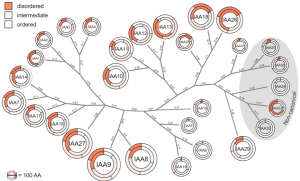 Auxin is involved in multiple plant development and stress response which necessitates complexity in auxin signaling. Auxin at a particular threshold in the cells brings together the TIR1/AFB1-5 (TRANSPORT INHIBITOR RESPONSE1/ AUXIN SIGNALING F-BOX 1-5) members and members of the 29 Aux/IAA members bound to the activator ARF (AUXIN RESPONSE FACTOR) transcriptional factors. This complex is presented for ubiquitin-mediated degradation by the SCF complex which alters Aux/IAA levels and repression state of the ARF proteins. In this paper, the authors investigated the complexity in structural properties of two Aux/IAA proteins, IAA7 and IAA12 which can alter the TIR1-Aux/IAA complex. IAA7 and IAA12 possess an intrinsically disordered domain that changes the protein conformation and plays a vital role in the auxin signaling through specific interaction with TIR1. This structural information about the Aux/IAA –AUXIN-TIR1 interaction complex will aid in understanding the regulation of auxin-responsive gene expression necessary for plant growth. Summary by Suresh Damodaran. BioRxiv, http://dx.doi.org/10.1101/787770.
Auxin is involved in multiple plant development and stress response which necessitates complexity in auxin signaling. Auxin at a particular threshold in the cells brings together the TIR1/AFB1-5 (TRANSPORT INHIBITOR RESPONSE1/ AUXIN SIGNALING F-BOX 1-5) members and members of the 29 Aux/IAA members bound to the activator ARF (AUXIN RESPONSE FACTOR) transcriptional factors. This complex is presented for ubiquitin-mediated degradation by the SCF complex which alters Aux/IAA levels and repression state of the ARF proteins. In this paper, the authors investigated the complexity in structural properties of two Aux/IAA proteins, IAA7 and IAA12 which can alter the TIR1-Aux/IAA complex. IAA7 and IAA12 possess an intrinsically disordered domain that changes the protein conformation and plays a vital role in the auxin signaling through specific interaction with TIR1. This structural information about the Aux/IAA –AUXIN-TIR1 interaction complex will aid in understanding the regulation of auxin-responsive gene expression necessary for plant growth. Summary by Suresh Damodaran. BioRxiv, http://dx.doi.org/10.1101/787770.


